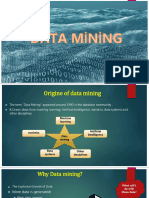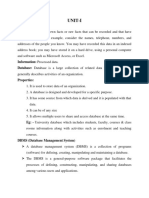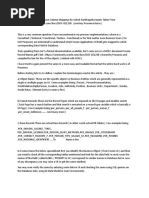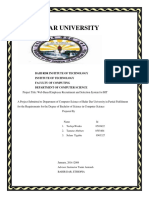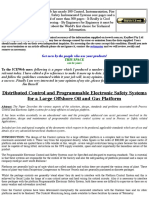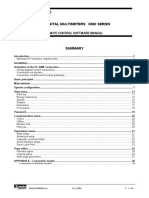Data Mining Process, Techniques, Tools & Examples
Uploaded by
tofy79Data Mining Process, Techniques, Tools & Examples
Uploaded by
tofy79Data Mining Process, Techniques, Tools &
Examples
What is Data Mining?
Data mining is looking for hidden, valid, and potentially useful patterns in huge
data sets. Data Mining is all about discovering unsuspected/ previously unknown
relationships amongst the data.
It is a multi-disciplinary skill that uses machine learning, statistics, AI and database
technology.
The insights derived via Data Mining can be used for marketing, fraud detection,
and scientific discovery, etc.
Data mining is also called as Knowledge discovery, Knowledge extraction,
data/pattern analysis, information harvesting, etc.
Types of Data
Data mining can be performed on following types of data
• Relational databases
• Data warehouses
• Advanced DB and information repositories
• Object-oriented and object-relational databases
• Transactional and Spatial databases
• Heterogeneous and legacy databases
• Multimedia and streaming database
• Text databases
• Text mining and Web mining
Ahmed Yasir Khan Page 1 of 11
Data Mining Implementation Process
Let's study the Data Mining implementation process in detail
Business understanding:
In this phase, business and data-mining goals are established.
• First, you need to understand business and client objectives. You need to
define what your client wants (which many times even they do not know
themselves)
• Take stock of the current data mining scenario. Factor in resources,
assumption, constraints, and other significant factors into your assessment.
• Using business objectives and current scenario, define your data mining
goals.
• A good data mining plan is very detailed and should be developed to
accomplish both business and data mining goals.
Data understanding:
In this phase, sanity check on data is performed to check whether its appropriate
for the data mining goals.
• First, data is collected from multiple data sources available in the
organization.
• These data sources may include multiple databases, flat filer or data cubes.
There are issues like object matching and schema integration which can
arise during Data Integration process. It is a quite complex and tricky process
as data from various sources unlikely to match easily. For example, table A
contains an entity named cust_no whereas another table B contains an
entity named cust-id.
Ahmed Yasir Khan Page 2 of 11
• Therefore, it is quite difficult to ensure that both of these given objects refer
to the same value or not. Here, Metadata should be used to reduce errors in
the data integration process.
• Next, the step is to search for properties of acquired data. A good way to
explore the data is to answer the data mining questions (decided in business
phase) using the query, reporting, and visualization tools.
• Based on the results of query, the data quality should be ascertained.
Missing data if any should be acquired.
Data preparation:
In this phase, data is made production ready.
The data preparation process consumes about 90% of the time of the project.
The data from different sources should be selected, cleaned, transformed,
formatted, anonymized, and constructed (if required).
Data cleaning is a process to "clean" the data by smoothing noisy data and filling in
missing values.
For example, for a customer demographics profile, age data is missing. The data is
incomplete and should be filled. In some cases, there could be data outliers. For
instance, age has a value 300. Data could be inconsistent. For instance, name of the
customer is different in different tables.
Data transformation operations change the data to make it useful in data mining.
Following transformation can be applied
Data transformation:
Data transformation operations would contribute toward the success of the mining
process.
Smoothing: It helps to remove noise from the data.
Aggregation: Summary or aggregation operations are applied to the data. I.e., the
weekly sales data is aggregated to calculate the monthly and yearly total.
Ahmed Yasir Khan Page 3 of 11
Generalization: In this step, Low-level data is replaced by higher-level concepts
with the help of concept hierarchies. For example, the city is replaced by the
county.
Normalization: Normalization performed when the attribute data are scaled up o
scaled down. Example: Data should fall in the range -2.0 to 2.0 post-normalization.
Attribute construction: these attributes are constructed and included the given
set of attributes helpful for data mining.
The result of this process is a final data set that can be used in modeling.
Modelling
In this phase, mathematical models are used to determine data patterns.
• Based on the business objectives, suitable modeling techniques should be
selected for the prepared dataset.
• Create a scenario to test check the quality and validity of the model.
• Run the model on the prepared dataset.
• Results should be assessed by all stakeholders to make sure that model can
meet data mining objectives.
Evaluation:
In this phase, patterns identified are evaluated against the business objectives.
• Results generated by the data mining model should be evaluated against the
business objectives.
• Gaining business understanding is an iterative process. In fact, while
understanding, new business requirements may be raised because of data
mining.
• A go or no-go decision is taken to move the model in the deployment phase.
Ahmed Yasir Khan Page 4 of 11
Deployment:
In the deployment phase, you ship your data mining discoveries to everyday
business operations.
• The knowledge or information discovered during data mining process
should be made easy to understand for non-technical stakeholders.
• A detailed deployment plan, for shipping, maintenance, and monitoring of
data mining discoveries is created.
• A final project report is created with lessons learned and key experiences
during the project. This helps to improve the organization's business policy.
Data Mining Techniques
Ahmed Yasir Khan Page 5 of 11
1.Classification:
This analysis is used to retrieve important and relevant information about data,
and metadata. This data mining method helps to classify data in different classes.
2. Clustering:
Clustering analysis is a data mining technique to identify data that are like each
other. This process helps to understand the differences and similarities between
the data.
3. Regression:
Regression analysis is the data mining method of identifying and analyzing the
relationship between variables. It is used to identify the likelihood of a specific
variable, given the presence of other variables.
4. Association Rules:
This data mining technique helps to find the association between two or more
Items. It discovers a hidden pattern in the data set.
5. Outer detection:
This type of data mining technique refers to observation of data items in the
dataset which do not match an expected pattern or expected behavior. This
technique can be used in a variety of domains, such as intrusion, detection, fraud
or fault detection, etc. Outer detection is also called Outlier Analysis or Outlier
mining.
6. Sequential Patterns:
This data mining technique helps to discover or identify similar patterns or trends
in transaction data for certain period.
Ahmed Yasir Khan Page 6 of 11
7. Prediction:
Prediction has used a combination of the other data mining techniques like trends,
sequential patterns, clustering, classification, etc. It analyzes past events or
instances in a right sequence for predicting a future event.
Challenges of Implementation of Data mine:
• Skilled Experts are needed to formulate the data mining queries.
• Overfitting: Due to small size training database, a model may not fit future
states.
• Data mining needs large databases which sometimes are difficult to manage
• Business practices may need to be modified to determine to use the
information uncovered.
• If the data set is not diverse, data mining results may not be accurate.
• Integration information needed from heterogeneous databases and global
information systems could be complex
Data mining Examples:
Example 1:
Consider a marketing head of telecom service provides who wants to increase
revenues of long-distance services. For high ROI on his sales and marketing efforts
customer profiling is important. He has a vast data pool of customer information
like age, gender, income, credit history, etc. But its impossible to determine
characteristics of people who prefer long distance calls with manual analysis.
Using data mining techniques, he may uncover patterns between high long
distance call users and their characteristics.
For example, he might learn that his best customers are married females between
the age of 45 and 54 who make more than $80,000 per year. Marketing efforts can
be targeted to such demographic.
Ahmed Yasir Khan Page 7 of 11
Example 2:
A bank wants to search new ways to increase revenues from its credit card
operations. They want to check whether usage would double if fees were halved.
Bank has multiple years of record on average credit card balances, payment
amounts, credit limit usage, and other key parameters. They create a model to
check the impact of the proposed new business policy. The data results show that
cutting fees in half for a targeted customer base could increase revenues by $10
million.
Data Mining Tools
Following are 2 popular Data Mining Tools widely used in Industry
R-language:
R language is an open source tool for statistical computing and graphics. R has a
wide variety of statistical, classical statistical tests, time-series analysis,
classification and graphical techniques. It offers effective data handling and
storage facility.
Oracle Data Mining:
Oracle Data Mining popularly knowns as ODM is a module of the Oracle Advanced
Analytics Database. This Data mining tool allows data analysts to generate detailed
insights and makes predictions. It helps predict customer behavior, develops
customer profiles, identifies cross-selling opportunities.
Benefits of Data Mining:
• Data mining technique helps companies to get knowledge-based
information.
• Data mining helps organizations to make the profitable adjustments in
operation and production.
• The data mining is a cost-effective and efficient solution compared to other
statistical data applications.
• Data mining helps with the decision-making process.
Ahmed Yasir Khan Page 8 of 11
• Facilitates automated prediction of trends and behaviors as well as
automated discovery of hidden patterns.
• It can be implemented in new systems as well as existing platforms
• It is the speedy process which makes it easy for the users to analyze huge
amount of data in less time.
Disadvantages of Data Mining
• There are chances of companies may sell useful information of their
customers to other companies for money. For example, American Express
has sold credit card purchases of their customers to the other companies.
• Many data mining analytics software is difficult to operate and requires
advance training to work on.
• Different data mining tools work in different manners due to different
algorithms employed in their design. Therefore, the selection of correct data
mining tool is a very difficult task.
• The data mining techniques are not accurate, and so it can cause serious
consequences in certain conditions.
Ahmed Yasir Khan Page 9 of 11
Applications Usage
Communications Data mining techniques are used in communication sector to predict
customer behavior to offer highly targeted and relevant campaigns.
Insurance Data mining helps insurance companies to price their products profitable
and promote new offers to their new or existing customers.
Education Data mining benefits educators to access student data, predict achievement
levels and find students or groups of students which need extra attention.
For example, students who are weak in maths subject.
Manufacturing With the help of Data Mining Manufacturers can predict wear and tear of
production assets. They can anticipate maintenance which helps them
reduce them to minimize downtime.
Banking Data mining helps finance sector to get a view of market risks and manage
regulatory compliance. It helps banks to identify probable defaulters to
decide whether to issue credit cards, loans, etc.
Retail Data Mining techniques help retail malls and grocery stores identify and
arrange most sellable items in the most attentive positions. It helps store
owners to comes up with the offer which encourages customers to increase
their spending.
Service Providers Service providers like mobile phone and utility industries use Data Mining to
predict the reasons when a customer leaves their company. They analyze
billing details, customer service interactions, complaints made to the
company to assign each customer a probability score and offers incentives.
E-Commerce E-commerce websites use Data Mining to offer cross-sells and up-sells
through their websites. One of the most famous names is Amazon, who use
Data mining techniques to get more customers into their eCommerce store.
Ahmed Yasir Khan Page 10 of 11
Super Markets Data Mining allows supermarket's develop rules to predict if their shoppers
were likely to be expecting. By evaluating their buying pattern, they could
find woman customers who are most likely pregnant. They can start
targeting products like baby powder, baby shop, diapers and so on.
Crime Data Mining helps crime investigation agencies to deploy police workforce
Investigation (where is a crime most likely to happen and when?), who to search at a
border crossing etc.
Bioinformatics Data Mining helps to mine biological data from massive datasets gathered in
biology and medicine.
Where is Data Mining used?
Summary:
• Data Mining is all about explaining the past and predicting the future for
analysis.
• Data mining helps to extract information from huge sets of data. It is the
procedure of mining knowledge from data.
• Data mining process includes business understanding, Data Understanding,
Data Preparation, Modelling, Evolution, Deployment.
• Important Data mining techniques are Classification, clustering, Regression,
Association rules, Outer detection, Sequential Patterns, and prediction
• R-language and Oracle Data mining are prominent data mining tools.
• Data mining technique helps companies to get knowledge-based
information.
• The main drawback of data mining is that many analytics software is difficult
to operate and requires advance training to work on.
• Data mining is used in diverse industries such as Communications,
Insurance, Education, Manufacturing, Banking, Retail, Service providers,
eCommerce, Supermarkets Bioinformatics.
Ahmed Yasir Khan Page 11 of 11
You might also like
- Advance Database With Lab: Professor & Head (Department of Software Engineering)No ratings yetAdvance Database With Lab: Professor & Head (Department of Software Engineering)5 pages
- 5 Data Mining Proccess and Techniques - Week 7No ratings yet5 Data Mining Proccess and Techniques - Week 761 pages
- Business Understanding This Step Involves Understanding The Problem That Needs To Be Solved and Defining The Objectives of The Data Mining ProjectNo ratings yetBusiness Understanding This Step Involves Understanding The Problem That Needs To Be Solved and Defining The Objectives of The Data Mining Project5 pages
- Lecture - 1 02032023 095637am 1 29022024 124126pmNo ratings yetLecture - 1 02032023 095637am 1 29022024 124126pm33 pages
- WINSEM2024-25_MCSE615L_TH_VL2024250502897_2024-12-19_Reference-Material-INo ratings yetWINSEM2024-25_MCSE615L_TH_VL2024250502897_2024-12-19_Reference-Material-I58 pages
- M.E.-ISE-2023-25-60 PIS E31-RSA-Best Practices in Data MiningNo ratings yetM.E.-ISE-2023-25-60 PIS E31-RSA-Best Practices in Data Mining3 pages
- What Is Data Mining: Effective Data Collection WarehousingNo ratings yetWhat Is Data Mining: Effective Data Collection Warehousing21 pages
- Course Manual on Data Mining_CSC 425_015446No ratings yetCourse Manual on Data Mining_CSC 425_01544644 pages
- Mehrdad Jalali: Jalali@mshdiau - Ac.ir Jalali - Mshdiau.ac - IrNo ratings yetMehrdad Jalali: Jalali@mshdiau - Ac.ir Jalali - Mshdiau.ac - Ir27 pages
- Upgrade Oracle E-Business Suite From 12.1.3 To 12.2.7No ratings yetUpgrade Oracle E-Business Suite From 12.1.3 To 12.2.71 page
- Exadata Database Machine Models X2-2 and X2-8 Technology Support SpecialistNo ratings yetExadata Database Machine Models X2-2 and X2-8 Technology Support Specialist19 pages
- Create A Composable Commerce Site With Contentful and Medusa - ContentfulNo ratings yetCreate A Composable Commerce Site With Contentful and Medusa - Contentful21 pages
- Overview of Transaction Processing and Enterprise Resource Planning SystemsNo ratings yetOverview of Transaction Processing and Enterprise Resource Planning Systems34 pages
- ICT Information and Communications Technology Training Package Release 9.0No ratings yetICT Information and Communications Technology Training Package Release 9.0141 pages
- Usefulness of Accounting Information System in Emerging Economy: Empirical Evidence of IranNo ratings yetUsefulness of Accounting Information System in Emerging Economy: Empirical Evidence of Iran10 pages
- Full Security Architecture - How & Why (River Publishers Series in Security and Digital Forensics) 1st Edition Tom Madsen Ebook All Chapters100% (4)Full Security Architecture - How & Why (River Publishers Series in Security and Digital Forensics) 1st Edition Tom Madsen Ebook All Chapters49 pages
- Informatica Power Exchange Architecture PDF50% (2)Informatica Power Exchange Architecture PDF24 pages
- Laserfiche Avante 10.4 Deployment GuideNo ratings yetLaserfiche Avante 10.4 Deployment Guide29 pages
- Modern Systems Analysis and Design: Ninth EditionNo ratings yetModern Systems Analysis and Design: Ninth Edition62 pages
- Indian Oil Corporation: Project ManthanNo ratings yetIndian Oil Corporation: Project Manthan23 pages
- Digital Multimeters DMK Series Remote Control Software ManualNo ratings yetDigital Multimeters DMK Series Remote Control Software Manual40 pages
- Introduction To Data Science: Rutvik BarbhaiNo ratings yetIntroduction To Data Science: Rutvik Barbhai1 page
- Advance Database With Lab: Professor & Head (Department of Software Engineering)Advance Database With Lab: Professor & Head (Department of Software Engineering)
- Business Understanding This Step Involves Understanding The Problem That Needs To Be Solved and Defining The Objectives of The Data Mining ProjectBusiness Understanding This Step Involves Understanding The Problem That Needs To Be Solved and Defining The Objectives of The Data Mining Project
- WINSEM2024-25_MCSE615L_TH_VL2024250502897_2024-12-19_Reference-Material-IWINSEM2024-25_MCSE615L_TH_VL2024250502897_2024-12-19_Reference-Material-I
- M.E.-ISE-2023-25-60 PIS E31-RSA-Best Practices in Data MiningM.E.-ISE-2023-25-60 PIS E31-RSA-Best Practices in Data Mining
- What Is Data Mining: Effective Data Collection WarehousingWhat Is Data Mining: Effective Data Collection Warehousing
- Mehrdad Jalali: Jalali@mshdiau - Ac.ir Jalali - Mshdiau.ac - IrMehrdad Jalali: Jalali@mshdiau - Ac.ir Jalali - Mshdiau.ac - Ir
- Upgrade Oracle E-Business Suite From 12.1.3 To 12.2.7Upgrade Oracle E-Business Suite From 12.1.3 To 12.2.7
- Exadata Database Machine Models X2-2 and X2-8 Technology Support SpecialistExadata Database Machine Models X2-2 and X2-8 Technology Support Specialist
- Create A Composable Commerce Site With Contentful and Medusa - ContentfulCreate A Composable Commerce Site With Contentful and Medusa - Contentful
- Overview of Transaction Processing and Enterprise Resource Planning SystemsOverview of Transaction Processing and Enterprise Resource Planning Systems
- ICT Information and Communications Technology Training Package Release 9.0ICT Information and Communications Technology Training Package Release 9.0
- Usefulness of Accounting Information System in Emerging Economy: Empirical Evidence of IranUsefulness of Accounting Information System in Emerging Economy: Empirical Evidence of Iran
- Full Security Architecture - How & Why (River Publishers Series in Security and Digital Forensics) 1st Edition Tom Madsen Ebook All ChaptersFull Security Architecture - How & Why (River Publishers Series in Security and Digital Forensics) 1st Edition Tom Madsen Ebook All Chapters
- Digital Multimeters DMK Series Remote Control Software ManualDigital Multimeters DMK Series Remote Control Software Manual

















































